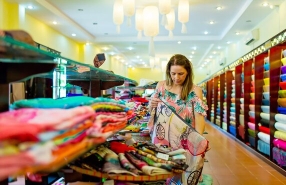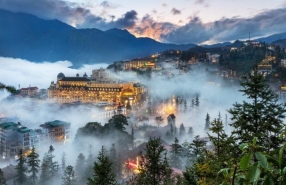Red Dao Herbal Baths In Sapa, Vietnam - The Cultural Treasures
Sunday, April 28, 2024
Places to visit & things to do

The Red Dao herbal baths in Sapa, Lao Cai aren't just about health care; they're a cornerstone of their cultural identity, steeped in their indigenous knowledge. With tourism trends shifting towards holistic experiences, where travelers seek both exploration and wellness, these traditional remedies are gaining newfound importance. As travelers embark on longer journeys, they're not just sightseeing—they're also prioritizing rejuvenation and health. Thus, the herbal remedies of the Red Dao community in Lao Cai are more valuable now than ever.
Table of Contents
1. The Red Dao Herbal Bath - Green Treasure of the Forest
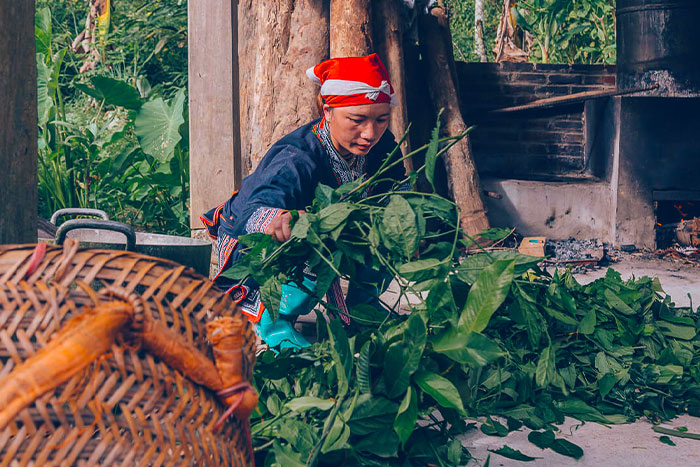
In many ethnic communities in the mountainous regions, apart from traditional remedies like herbal extracts, medicinal wines, medicinal pastes for ingestion, and bone-setting plasters, there exists the tradition of herbal baths of the Red Dao people. For the Dao community, herbal remedies truly are treasures of the forest.
Since time immemorial, the lives of the Red Dao people have been intertwined with the forest. The forest is their home, providing sustenance and valuable gifts—medicinal leaves—to them. Herbal baths of the Red Dao people are a distinctive form of utilizing plants as medicine for health care and treatment, representing a beautiful cultural and traditional medicinal practice among various ethnic communities in Vietnam. Herbal baths (referred to as "Đìa dảo xin" in the Dao language) are not exclusive to the Red Dao in Sa Pa Vietnam but are also practiced by other Dao groups across the country.
According to experienced herbalists of the community, each herbal bath recipe of the Red Dao comprises 10-120 types of leaves and stems from different medicinal plants. Each Red Dao family holds its own herbal bath recipe, typically passed down from mothers to daughters. However, the herbs used for making these baths are scattered throughout the mountains, and not everyone knows where to find them. Proper preparation methods vary for each type of herb to ensure optimal efficacy. Some herbs require drying or roasting correctly, while others are best used fresh. For certain rare plants, they need to be preserved for year-round use by drying them (usually bundled into small bundles and stored on kitchen shelves).
Based on the experience of the Red Dao people, herbal baths are ideally taken in wooden tubs made of "Pơmu" wood. "Pơmu" wood emits a pleasant aroma, which, when combined with the hot herbal bath water, maximizes the medicinal benefits of the herbal concoction.
2. The benefits of Red Dao Herbal Bathing
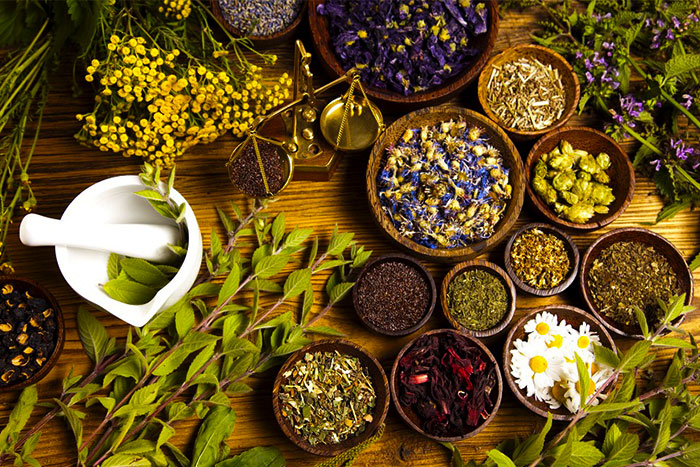
The recipe of herbal bath of Red Dao people combines various types of herbs beneficial for the skin (such as "kim ngân", "lá khế", "thìa là", "lá vối", "long não", "hoàng bá nam"), beneficial for bones and joints (such as "thanh táo", "thổ lục linh", "thiên niên kiện", "đào rừng", "bách quản", "tam huyết", "tân quy", "lá lốt"), and effective for digestion (such as "sa nhân", "sả", "hồi", "quế", "thủy xương bồ", "màng tang", "mạn khâu tử", etc...). For the Red Dao community, before the 1990s, transportation was difficult, and people had little access to hospitals, which is why these medicinal plants were considered treasures of the forest. Ailments like joint pain, numbness in limbs, and general weakness were alleviated with the use of precious forest herbs. Especially for Red Dao women after childbirth, they all use herbal leaves for bathing. After bathing with the herbal concoction for 2-4 times, within just half of a month, they can resume their daily activities. Regular bathing with herbal water for children helps eliminate skin rashes and other skin conditions.
In modern wellness terms, these baths combine hydrotherapy and aromatherapy to enhance blood circulation, promote relaxation, and alleviate body pain. The herbal ingredients gently cleanse pores and soothe the skin. After your trekking tour Sapa, there's nothing quite like indulging in a rejuvenating herbal bath to relax and revitalize.
Take a look at Top Sapa things to do
3. Preparing a Red Dao Herbal Bath - A Journey into Nature

Crafting the perfect herbal bath of the Red Dao people involves a meticulous process that begins with the arduous task of sourcing the necessary ingredients from the depths of the forest. The journey to gather these medicinal herbs is a challenging one, fraught with difficulties and hardships.
Navigating through the rugged terrain, one must ascend higher altitudes of the mountains, as the low-lying areas merely offer a sparse selection of herbs. To gather approximately 30 types of medicinal leaves, one must venture deep into the heart of the mountains, even crossing over to neighboring mountains.
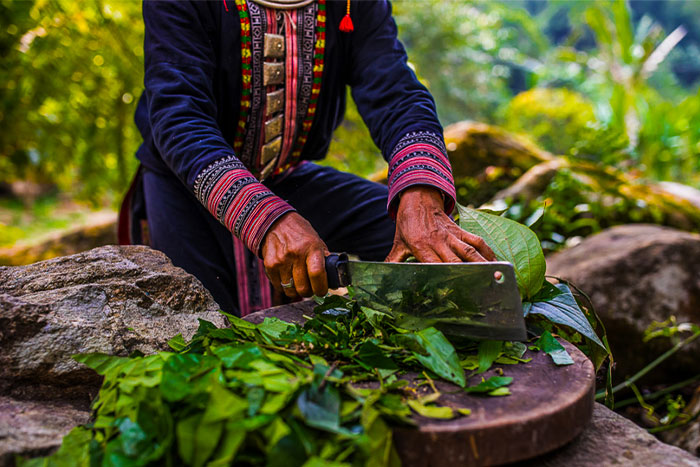
However, finding these precious herbs is not guaranteed, as some are elusive and may only be encountered a few times a year. Upon discovery, they are meticulously harvested, finely chopped, and carefully dried to ensure longevity. The meticulous process of drying involves thorough attention to detail, as each valuable herb may be preserved for months, if not years.
The medicinal properties of Red Dao herbal baths in Sapa inherent in these natural remedies bring not only physical relief but also mental tranquility. Boiling the herbs for several hours releases their essence, infusing the water with therapeutic benefits.

Accompanying a Red Dao woman on her quest for these herbs reveals the true extent of dedication and effort required to assemble the ingredients for this revered "elixir." The collection of medicinal plants is no easy feat, requiring early morning excursions to capture the essence of dew-kissed foliage.
Only the branches and leaves are harvested, leaving the roots intact to ensure regrowth for future harvests. The final step involves carefully cutting and sun-drying the herbs, a process that ensures their potency and longevity. Despite the convenience of dried herbs, the Red Dao people attest to the superior efficacy of using fresh ingredients.
The herbal bath of Red Dao’s secrets have been passed down through generations, embodying the wisdom and traditions of the Red Dao culture. Each step of the preparation process is steeped in reverence for nature's gifts and a deep understanding of the therapeutic properties inherent in these botanical treasures.
4. Essential notes for the experience of Red Dao Herbal Bath
While herbal baths offer numerous health advantages, it's crucial to consider the following:
- Individuals with a history of heart disease or hypertension should avoid hot herbal baths to minimize the risk of elevated heart rate and stroke.
- Pregnant women need to exercise caution as the high temperatures of herbal baths can trigger uterine contractions, potentially leading to premature labor or miscarriage. Additionally, heightened blood flow may exacerbate menstrual cramps.
- Avoid herbal baths if you have skin conditions like ulcers, infections, allergies, or deep wounds to prevent further complications and hindered healing.
- It's advisable to neither be excessively hungry nor full before taking herbal baths to prevent fatigue, dizziness, headaches, and potential drug interactions.
The Red Dao herbal baths in Sapa experience isn't just about physical therapy; it's a cultural odyssey entrenched in the traditions of the Red Dao community. Beyond its therapeutic benefits, these baths serve as a ritualistic practice symbolizing renewal, wellness, and a connection to ancestral customs. Engaging in this ancient tradition offers not only bodily rejuvenation but also profound insights into the rich cultural heritage of the region. To ensure a satisfying experience far beyond your expectations, please contact Autour Asia - TRAVEL AGENTS IN VIETNAM now.
Related travel guide
Other similar articles
CUSTOMIZABLE BY LOCAL EXPERTS
Personalized trip at the original price!
REFUND GUARANTEE
We believe in our work and promise to give you money back.
GOOD PRICE / QUALITY
95% satisfied more than expected!
24/7 LOCAL SUPPORT
We are always available online to provide assistance at any time.
Most read articles
Autour Asia is highly recommended on
Embracing the mission of "Satisfied more than expected" and providing authentic experiences, we have received numerous recommendations on reputable travel forums:















